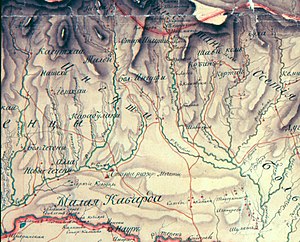Act of oath of six Ingush clans to Russia
This article is an orphan, as no other articles link to it. Please introduce links to this page from related articles; try the Find link tool for suggestions. (December 2024) |
| Type | Pact |
|---|---|
| Signed | August 22, 1810 |
| Location | Vladikavkaz |
| Signatories | |
| Languages | Russian |
The Act of oath of six Ingush clans to Russia (Russian: Акт присяги шести ингушских фамилий России, romanized: Akt prisyagi shesti ingushkikh familii Rossii) was a treaty between ten representatives of six major Ingush clans (teips) and the Russian Empire. It was signed on August 22, 1810 in the city of Vladikavkaz.[1] Due to this oath, the Ingush were given the right to settle the land along the right bank of the Terek up to the ridge.

History
[edit]According to historians [which?] numerous Ingush clans approached the Russians since the 18th century, petitioning for the integration into the Russian Empire.[2] First diplomatic relationships were achieved in 1770, when 24 elders took the oath to join Russia near the village of Angusht between the 4th and 6 March.[3] The location of this event, the village Angusht, is the namesake of the Ingush people.
However it is worth saying that even after the oath of individual Ingush society or clans, the former Russian-Ingush relations remained the same. In fact, both sides took these type of oaths as a conclusion union treaties.[4] So, during the Caucasian War, the Ingush introduced resistance against the tsarist government, and in every possible way made uprisings and skirmishes against the Russians. On the side of Caucasian Imamate, the Ingush from the societies of Karabulaks and Galashians also fought.[5]
Granat Encyclopedic Dictionary states that the Ingush despite being nominally under Russian rule, were long time completely independent and repeatedly fought against the Russians.[6]
Involved parties
[edit]General Delpozzo, the commander of the Vladikavkaz fortress, represented the Russian Empire while the influential Ingush clans were represented by ten elders from the six major teips, which were the Targimkhoi, Khamkhoi, Ozdoi, Egikhoi, Kartoi and Yovloy.[7]
Content of the oath
[edit]With the oath, the clans obliged themselves to fulfill several duties. These duties included the task to deploy fully equipped detachments of at least 1000 people to fight the enemies of Russia (mentioned by name are the Chechens and Karabulaks), report attacks on fortresses, transfer representatives of hostile groups to the Russian authorities and ensure the unhindered passage of Russian troops through villages. If these obligations were broken, the violater would be declared a traitor and rioter and would be dealt with by the Russian command.[8]
Notes
[edit]References
[edit]- ^ "Исторические документы свидетельствуют о добровольном вхождении Ингушетии в состав России".
- ^ "22 августа 1810 года подписан акт о присоединении ингушей к России".
- ^ Гюльденштедт, И. А. Географические и статистические описания Кавказа. p. 1809.
- ^ Долгиева et al. 2013, p. 236.
- ^ Кавказская война и Ингушетия. Дата обращения: 21 декабря. 2009.
- ^ Максимов 1914.
- ^ Кодзоев 2002.
- ^ "Прошение ингушей о принятии подданство России".
Bibliography
[edit]- Долгиева, М. Б.; Картоев, М. М.; Кодзоев, Н. Д.; Матиев, Т. Х. (2013). Кодзоев, Н. Д. (ed.). История Ингушетии [History of Ingushetia] (4th ed.). Ростов-на-Дону: Южный издательский дом. pp. 1–600. ISBN 978-5-98864-056-1.
- Максимов, А. М. (1914). [The Ingush]. In Гамбаров, Ю. С.; Железнов, В. Я.; Ковалевскій, М. М.; Муромцев, С. А.; Тимирязев, К. А. (eds.). Энциклопедическій словарь Гранатъ (in Russian). Vol. 21: Звукъ — Индія (7th ed.). Москва: Издательство Т-ва „Бр. А. и И. Гранатъ и К°“. p. 609 – via Wikisource.
- Кодзоев, Н. Д. (2002). История ингушского народа. Глава 5. ГЛАВА 5 ИНГУШЕТИЯ В XIX В. § 1. Ингушетия в первой половине XIX в. Основание Назрани [History of the Ingush people. Chapter 5. CHAPTER 5 INGUSHETIA IN THE XIX CENTURY § 1. Ingushetia in the first half of the XIX century. Foundation of Nazran] (in Russian). Archived from the original on 2019-07-23.
